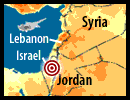|








|
 |
Pick a Region:.
. The Middle East

Political
There is no single, agreed-upon,
definition of what specifically constitutes the Middle East. Defining
the Middle East through ethnicity, religion, or national identity
is problematic (see Peoples). Therefore,
for the purposes of this module, the Middle East will include the
states of Egypt, Saudi Arabia, Yemen, Oman, United Arab Emirates (UAE),
Qatar, Bahrain, Kuwait, Iran, Iraq, Syria, Turkey, Lebanon, Jordan,
and Israel (see political
map).
It is important to note
that at this time there is no state of Palestine--only territories
(the Gaza Strip and portions of the West Bank) within the Middle East
that are controlled by the Palestinian National Authority.
Physical
The Middle East region
represents an area of over 5.0 million square miles. The physical
geography of the Middle East is varied. Vast deserts are common in
the region. The Sahara Desert runs across North Africa, essentially limiting settlement
to along the Mediterranean coastline and in Egypt along
the Nile River. The desert of the Arabian Peninsula is so inhospitable
that it has been given the name "The Empty Quarter." Other
significant deserts exist throughout the region. In areas better served
by rainfall and rivers (for example the Tigris-Euphrates river system,
the Jordan River, and along the Mediterranean coast), rich agriculture
is abundant. Mountain ranges exist throughout the region with some
peaks rising as high as 19,000 feet. Snow is a common sight in these
mountain ranges. Between the mountains, high plateaus are common
(see physical map).
Ease of movement in and
out of the Middle East by water is also affected by the presence of a number
of narrow water passageways. Gibraltar controls the water route linking
the Atlantic Ocean and the Mediterranean Sea. Water access between
the Mediterranean and Black Seas is only possible through the
Bosporus and the Dardanelles, which in some places is only half a mile wide. Other critical
water routes would include: the Suez Canal, which links the Mediterranean
Sea to the Red Sea; Bab el Mandeb, a strait that separates the Red Sea from
the Indian Ocean; and the Strait of Hormuz, which links the Persian
Gulf and the Indian Ocean.
Environmental
As for climate, the region again displays a great variety. In the
desert areas, rainfall is low, averaging about four inches per year.
Temperatures in such areas show great extremes. Along the coast of
the Mediterranean Sea, as well as the Black and Caspian Seas, the
water serves to lessen the temperature extremes of the desert resulting
in a more moderate climate that is similar to that of southern Italy
or California.
|
 |



    
|

